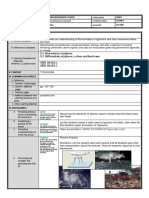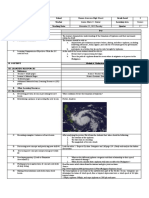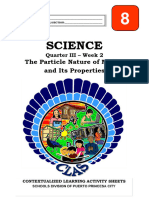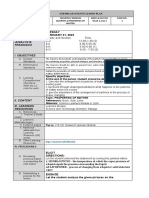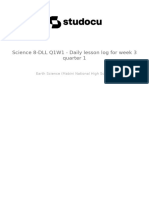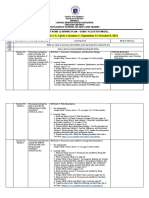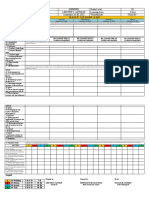0 ratings0% found this document useful (0 votes)
85 viewsDLL - g8
DLL - g8
Uploaded by
AndrewdKiatKiatThis document outlines a science lesson plan for an 8th grade class about typhoons. Over the course of the week, students will learn about typhoon formation and movement, conditions required for typhoons to form, and how landmasses and bodies of water affect typhoons. Activities include performing experiments on typhoon formation, watching educational videos, and constructing a typhoon exhibit. The goal is for students to understand typhoons and demonstrate precautions before, during, and after typhoons, including following government advisories and evacuation orders.
Copyright:
© All Rights Reserved
Available Formats
Download as DOCX, PDF, TXT or read online from Scribd
DLL - g8
DLL - g8
Uploaded by
AndrewdKiatKiat0 ratings0% found this document useful (0 votes)
85 views4 pagesThis document outlines a science lesson plan for an 8th grade class about typhoons. Over the course of the week, students will learn about typhoon formation and movement, conditions required for typhoons to form, and how landmasses and bodies of water affect typhoons. Activities include performing experiments on typhoon formation, watching educational videos, and constructing a typhoon exhibit. The goal is for students to understand typhoons and demonstrate precautions before, during, and after typhoons, including following government advisories and evacuation orders.
Original Title
dll - g8
Copyright
© © All Rights Reserved
Available Formats
DOCX, PDF, TXT or read online from Scribd
Share this document
Did you find this document useful?
Is this content inappropriate?
This document outlines a science lesson plan for an 8th grade class about typhoons. Over the course of the week, students will learn about typhoon formation and movement, conditions required for typhoons to form, and how landmasses and bodies of water affect typhoons. Activities include performing experiments on typhoon formation, watching educational videos, and constructing a typhoon exhibit. The goal is for students to understand typhoons and demonstrate precautions before, during, and after typhoons, including following government advisories and evacuation orders.
Copyright:
© All Rights Reserved
Available Formats
Download as DOCX, PDF, TXT or read online from Scribd
Download as docx, pdf, or txt
0 ratings0% found this document useful (0 votes)
85 views4 pagesDLL - g8
DLL - g8
Uploaded by
AndrewdKiatKiatThis document outlines a science lesson plan for an 8th grade class about typhoons. Over the course of the week, students will learn about typhoon formation and movement, conditions required for typhoons to form, and how landmasses and bodies of water affect typhoons. Activities include performing experiments on typhoon formation, watching educational videos, and constructing a typhoon exhibit. The goal is for students to understand typhoons and demonstrate precautions before, during, and after typhoons, including following government advisories and evacuation orders.
Copyright:
© All Rights Reserved
Available Formats
Download as DOCX, PDF, TXT or read online from Scribd
Download as docx, pdf, or txt
You are on page 1of 4
Grades 1 – 12 School Grade Level GRADE 8
DAILY LESSON Teacher Learning Area SCIENCE
LOG Teaching Dates and Time Quarter FIRST
MONDAY TUESDAY WEDNESDAY THURSDAY FRIDAY
I. OBJECTIVES
A. Content Standards The learners demonstrate an understanding of the formation of typhoons and their movement within the PAR.
B. Performance Standards The learners shall be able to:
a. demonstrate precautionary measures before, during, and after a typhoon, including following advisories, storm signals, and calls for evacuation given
by government agencies in charge
b. participate in activities that lessen the risks brought about by typhoons
C. Learning Competencies The learners should be able to:
a. explain how typhoons develop;
b. infer why the Philippines is prone to typhoons;
c. explain how landmasses and bodies of water affect typhoons;
d. trace the path of typhoons that enter the Philippine Area of Responsibility (PAR) using a map and tracking data.
D. Learning Objectives 1. Perform an activity on how typhoons 1. Explain what a typhoon is, how 1. Describe the movement of tropical 1. Construct a typhoon exhibit;
form; and why it is formed, and how it cyclones 2. Collaborate and work
2. Work harmoniously in groups. dissipates; 2. Listen and respect one another’s harmoniously with group mates and
2. Describe the classifications of ideas and reasoning classmates to accomplish tasks
typhoons; assigned.
II. CONTENT UNDERSTANDING TYPHOONS UNDERSTANDING TYPHOONS UNDERSTANDING TYPHOONS UNDERSTANDING TYPHOONS
III. LEARNING RESOURCES
A. References
1. Teacher’s Guide pages
2. Learner’s Materials pages LM 137 - 149 LM 137 - 149 LM 137 - 149 LM 137 - 149
3. Textbook pages
4. Additional Materials from www.youtube.com
Learning Resource (LR) portal
B. Other Learning Television, laptop, container, glitters, Television, laptop Television, laptop Television, laptop
Resources/Materials dishwashing liquid, dye
IV. PROCEDURES
A. Reviewing previous lesson or *Have a quick round robin where each
presenting the new lesson student has to share what they have
(ELICIT) learned about earthquakes and faults.
B. Establishing a purpose for the *Students will construct comments on
lesson (ENGAGE) the pictures that will be shown to them
about the effects of typhoon.
C. Presenting examples/instances of
the new lesson (ENGAGE)
D. Discussing new concepts and *Let the learners perform an activity on
practicing new skills 1(EXPLORE) how typhoons form and develop.
E. Discussing new concepts & .
practicing new skills 2(EXPLORE)
F. Developing mastery *Presentation of output
(Leads to Formative Assessment) *Discuss the concept of typhoon and
(EXPLAIN) classifications through PPT
*Let the learners watch a video clip
about typhoon.
G. Finding practical application of *Let the learners share ideas about
concepts and skills in daily living the video clip.
(ELABORATE) *Describe also the movement of
tropical cyclones and the conditions
do tropical cyclones form
H. Making generalizations and
abstractions about the lesson
(ELABORATE)
I. Evaluating learning Learners will make their own graphic
(EVALUATE) organizer about the cause and effects
of typhoon.
J. Additional activities for application *Let the students construct a
or remediation “typhoon exhibit” where they will
(EXTEND) display their output and answers
V. REMARKS
VI. REFLECTION
A. No. of learners who earned 80 %
on this formative assessment
B. No. of learners who require
additional activities for remediation
C. Did the remedial lessons work?
No. of learners who have caught up
the lesson
D. No. of learners who continue to
require remediation
E. Which of my teaching strategies
worked well? Why did these
worked?
F. What difficulties did I encounter
which my principal or supervisor can
help me solve?
G. What innovation or localized
materials did I use/discover which I
wish to share with other teachers?
Prepared by: RYAN R. TOBIAS
Writer
Grades 1 – 12 School Grade Level GRADE 8
DAILY LESSON Teacher Learning Area SCIENCE
LOG Teaching Dates and Time Quarter FIRST
MONDAY TUESDAY WEDNESDAY THURSDAY FRIDAY
I. OBJECTIVES
A. Content Standards The learners demonstrate an understanding of the formation of typhoons and their movement within the PAR.
B. Performance Standards The learners shall be able to:
a. demonstrate precautionary measures before, during, and after a typhoon, including following advisories, storm signals, and calls for evacuation given
by government agencies in charge
b. participate in activities that lessen the risks brought about by typhoons
C. Learning Competencies The learners should be able to:
a. explain how typhoons develop;
b. infer why the Philippines is prone to typhoons;
c. explain how landmasses and bodies of water affect typhoons;
d. trace the path of typhoons that enter the Philippine Area of Responsibility (PAR) using a map and tracking data.
D. Learning Objectives 1. Perform an activity about plotting 1. Enumerate and explain why and 1. Discuss and enumerate the 1. Appreciate the importance of
the Philippine Area of Responsibility; where typhoons occur in the different public storm warning signals bayanihan spirit of the Filipinos
2. Work harmoniously in groups. Philippines; 2. Appreciate the importance of during typhoons.
2. Describe the conditions of a knowing the public storm warning
typhoon based on the Philippine signals;
public storm warning signal;
II. CONTENT TYPHOONS IN THE PHILIPPINES TYPHOONS IN THE PHILIPPINES TYPHOONS IN THE PHILIPPINES TYPHOONS IN THE PHILIPPINES
III. LEARNING RESOURCES
A. References
1. Teacher’s Guide pages
2. Learner’s Materials pages LM 137 - 149 LM 137 - 149 LM 137 - 149 LM 137 - 149
3. Textbook pages
4. Additional Materials from
Learning Resource (LR) portal
B. Other Learning Television, laptop Television, laptop Television, laptop Television, laptop
Resources/Materials
IV. PROCEDURES
A. Reviewing previous lesson or *Let the learners do “Pair & Share”.
presenting the new lesson
(ELICIT)
B. Establishing a purpose for the *Learners will perform picture analysis.
lesson (ENGAGE)
C. Presenting examples/instances of
the new lesson (ENGAGE)
D. Discussing new concepts and Let the learners perform an activity
practicing new skills 1(EXPLORE) entitled, “Plotting the PAR” on page
140 – 142 (LM)
E. Discussing new concepts & .
practicing new skills 2(EXPLORE)
F. Developing mastery *Let the students present their output.
(Leads to Formative Assessment) *Ask: Why is the Philippines prone to
(EXPLAIN) typhoons?
*Describe also the conditions of a
typhoon based on the Philippine
public storm warning signal.
G. Finding practical application of *Let the learners share their
concepts and skills in daily living experiences with typhoons here in
(ELABORATE) the Philippines.
*Let the learners enumerate the
different precautionary measures
before, during and after a typhoon
H. Making generalizations and
abstractions about the lesson
(ELABORATE)
I. Evaluating learning(EVALUATE) Formative Assessment
J. Additional activities for application *Make an essay about the bayanihan
or remediation spirit of the Filipinos during typhoons.
V. REMARKS
VI. REFLECTION
A. No. of learners who earned 80 %
on this formative assessment
B. No. of learners who require
additional activities for remediation
C. Did the remedial lessons work?
No. of learners who have caught up
the lesson
D. No. of learners who continue to
require remediation
E. Which of my teaching strategies
worked well? Why did these
worked?
F. What difficulties did I encounter
which my principal or supervisor can
help me solve?
G. What innovation or localized
materials did I use/discover which I
wish to share with other teachers?
You might also like
- Lesson Plan (Understanding Typhoon)Document6 pagesLesson Plan (Understanding Typhoon)jelena jorgeo100% (1)
- Sepak Takraw Training ProgramDocument2 pagesSepak Takraw Training ProgramAndrewdKiatKiat100% (5)
- DLL EarthquakeDocument2 pagesDLL EarthquakeJuvy Abellanosa IndacNo ratings yet
- 5.1. Characterize A Typhoon. 5.2. Differentiate A Typhoon, Cyclone and Hurricane. S8Es-Iid18.5.1 S8Es-Iid18.5.2Document3 pages5.1. Characterize A Typhoon. 5.2. Differentiate A Typhoon, Cyclone and Hurricane. S8Es-Iid18.5.1 S8Es-Iid18.5.2Carla NicolasNo ratings yet
- DLP Jan. 9, 2023Document3 pagesDLP Jan. 9, 2023Cath MartinezNo ratings yet
- Daily Lesson Log: Monday Tuesday Wednesday Thursday FridayDocument3 pagesDaily Lesson Log: Monday Tuesday Wednesday Thursday FridayKaren PolinarNo ratings yet
- 7es Lp-2nd QuarterDocument17 pages7es Lp-2nd QuarterLay SalesNo ratings yet
- LP For EarthquakeDocument6 pagesLP For Earthquakejelena jorgeoNo ratings yet
- Science8 DLLDocument156 pagesScience8 DLLMelanie Trinidad100% (1)
- Week 5. The Effect of Temperature To The Speed of SoundDocument2 pagesWeek 5. The Effect of Temperature To The Speed of SoundZENDLE ANN BARRAMEDANo ratings yet
- TyphoonDocument3 pagesTyphoonanon_178765166No ratings yet
- Par Cot2 Lesson PlanDocument10 pagesPar Cot2 Lesson PlanJeazel MosendoNo ratings yet
- Science 8 DLL Q1 Week 4Document5 pagesScience 8 DLL Q1 Week 4Jun De FontanozaNo ratings yet
- Sci8 Q2 M4 Understanding-TyphoonDocument30 pagesSci8 Q2 M4 Understanding-TyphoonMai MaiNo ratings yet
- Science Las Week4Document2 pagesScience Las Week4Rosita C.CayananNo ratings yet
- Q2 G8 DLP Week-4Document6 pagesQ2 G8 DLP Week-4C Aina Myles CabatbatNo ratings yet
- Science 8 q1 w3Document12 pagesScience 8 q1 w3Je-ann AcuNo ratings yet
- 2nd Quarter DLL in Science 8 Week 1Document4 pages2nd Quarter DLL in Science 8 Week 1Raiza Lainah Miano100% (1)
- Department of Education: Republic of The PhilippinesDocument4 pagesDepartment of Education: Republic of The PhilippinesChristine Marquez RamosNo ratings yet
- DAILY LESSON LOG School MUNOZ NATIONAL HDocument5 pagesDAILY LESSON LOG School MUNOZ NATIONAL HDison AcebucheNo ratings yet
- DLLQ3 Endocrine System Feb.2023Document4 pagesDLLQ3 Endocrine System Feb.2023Marion Allen AlbaladejoNo ratings yet
- Summative Test #4GRADE 8Document2 pagesSummative Test #4GRADE 8Emily Tatunay EspejoNo ratings yet
- DLP Science 8 Wk3D2 2nd QTRDocument2 pagesDLP Science 8 Wk3D2 2nd QTRLianne Marie CabanginNo ratings yet
- 1ST Week Law of InertiaDocument5 pages1ST Week Law of InertiaMira VeranoNo ratings yet
- DLL Science 8 Q3 WK - 9 - JUDYDocument7 pagesDLL Science 8 Q3 WK - 9 - JUDYAlrei MeaNo ratings yet
- 1 Mendelian Genetics Preliminary ActivitiesDocument7 pages1 Mendelian Genetics Preliminary ActivitiesJenny PartozaNo ratings yet
- DAILYDocument3 pagesDAILYDiamond Crskt100% (1)
- Science 8 TOS - Quarter 4Document2 pagesScience 8 TOS - Quarter 4joan marie PeliasNo ratings yet
- Las (Grade 8) - TyphoonDocument4 pagesLas (Grade 8) - TyphoonMelvin Gayta FailagaoNo ratings yet
- DLP Science 8 Wk1D3 2nd QTRDocument1 pageDLP Science 8 Wk1D3 2nd QTRLianne Marie CabanginNo ratings yet
- Activity 3. Tracking A Tropical Cyclone - MAMURIDocument4 pagesActivity 3. Tracking A Tropical Cyclone - MAMURIEirik Nathan MamuriNo ratings yet
- DLL Grade 8 WorkDocument5 pagesDLL Grade 8 WorkIrish Joy Aguadera - Namuag100% (1)
- Week 3Document3 pagesWeek 3Jeanne Pauline OabelNo ratings yet
- Weekly Home Learning Plan in ScienceDocument14 pagesWeekly Home Learning Plan in ScienceRamir BecoyNo ratings yet
- Science 8 3rdquarter Atomic ParticlesDocument6 pagesScience 8 3rdquarter Atomic ParticlesShirlyn Lorenzana BuitreNo ratings yet
- DLL HeatDocument3 pagesDLL HeatMatet GenerosaNo ratings yet
- Science8 - q3 - CLAS2-the-particle-nature-of-matter-and-its-properties-v5 - Carissa CalalinDocument14 pagesScience8 - q3 - CLAS2-the-particle-nature-of-matter-and-its-properties-v5 - Carissa CalalinNoel PiedadNo ratings yet
- Daily Lesson Plan in Science Grade 8 SECOND QUARTER SY: 2019-2020Document5 pagesDaily Lesson Plan in Science Grade 8 SECOND QUARTER SY: 2019-2020Christian Aries C. LansanganNo ratings yet
- Par Cot2 Lesson Plan (Autorecovered)Document9 pagesPar Cot2 Lesson Plan (Autorecovered)Jeazel MosendoNo ratings yet
- DLP Where Is PhilDocument4 pagesDLP Where Is PhilGeorge Kim BarcelonaNo ratings yet
- GRACE 8 Quarter 4 Lesson 1Document32 pagesGRACE 8 Quarter 4 Lesson 1Mary Dianne BelgaNo ratings yet
- Q3 DLL Sci 8 W3Document6 pagesQ3 DLL Sci 8 W3Justin Abad FernandezNo ratings yet
- What Is The Difference Between Magnitude and IntensityDocument18 pagesWhat Is The Difference Between Magnitude and Intensitymark anthony NibresNo ratings yet
- AUG 6-10 DLLDocument4 pagesAUG 6-10 DLLLovieAlfonsoNo ratings yet
- 4 Quarter Grade 9 - NARRA (A-B) Week 1 Science: Weekly Learning PlanDocument4 pages4 Quarter Grade 9 - NARRA (A-B) Week 1 Science: Weekly Learning PlanChristine RamosNo ratings yet
- TRADITIONAL DLP ACTIVE AND INACTIVE (Semi Final)Document8 pagesTRADITIONAL DLP ACTIVE AND INACTIVE (Semi Final)Micha Ella Enriquez100% (1)
- LP Tropical Cyclone FormationDocument6 pagesLP Tropical Cyclone FormationNonitaNo ratings yet
- Dll. MATTER - DAY5.WEEK2.melting.3RDQDocument4 pagesDll. MATTER - DAY5.WEEK2.melting.3RDQjunalyn francisco100% (1)
- Q3 DLL Sci 8 W5Document4 pagesQ3 DLL Sci 8 W5Justin Abad FernandezNo ratings yet
- DLL 8-1Document3 pagesDLL 8-1Vy Rañoa Paz100% (1)
- Science-8-Dll-Q1w1-Daily-Lesson-Log-For-Week-3-Quarter-1 EditedDocument8 pagesScience-8-Dll-Q1w1-Daily-Lesson-Log-For-Week-3-Quarter-1 EditedNemcris Mae OpleNo ratings yet
- Detailed LP-Law of AccelerationDocument5 pagesDetailed LP-Law of AccelerationMarvie PabillarNo ratings yet
- Dissecting A TyphoonDocument8 pagesDissecting A TyphoonAPPLE JEAN YECYECNo ratings yet
- WLP q2 WK 4Document10 pagesWLP q2 WK 4Bing Sepe CulajaoNo ratings yet
- GRADE 10, Week 1-4, Cycle 1, Quarter 1, September 13-October 8, 2021Document4 pagesGRADE 10, Week 1-4, Cycle 1, Quarter 1, September 13-October 8, 2021orlan sison100% (1)
- DLL in Science 10 (Week 6)Document2 pagesDLL in Science 10 (Week 6)Lhester D. Antolin100% (1)
- DLP Science 8 Wk3D3 2nd QTRDocument2 pagesDLP Science 8 Wk3D3 2nd QTRLianne Marie CabanginNo ratings yet
- DLL Sci 8 Week 3 Q1Document8 pagesDLL Sci 8 Week 3 Q1Rhazel CaballeroNo ratings yet
- Grade 8 - Science - 2nd Quarter TestDocument10 pagesGrade 8 - Science - 2nd Quarter Testeddielyolvido1002100% (1)
- Cot DLP Science 7Document14 pagesCot DLP Science 7Janry Nino CaisedoNo ratings yet
- Daily Lesson Log: Laptop, ProjectorDocument5 pagesDaily Lesson Log: Laptop, ProjectorFabio Jr CapitoNo ratings yet
- Module 1 4Document15 pagesModule 1 4AndrewdKiatKiatNo ratings yet
- Personal Profile Grade 12Document2 pagesPersonal Profile Grade 12AndrewdKiatKiatNo ratings yet
- TeachersDocument3 pagesTeachersAndrewdKiatKiatNo ratings yet
- Name: Period:: Genetics Comparing Mitosis & MeiosisDocument2 pagesName: Period:: Genetics Comparing Mitosis & MeiosisAndrewdKiatKiatNo ratings yet
- DLL Earth Quake 1Document2 pagesDLL Earth Quake 1AndrewdKiatKiatNo ratings yet
- Core Requirements For Adult New ApplicationsDocument1 pageCore Requirements For Adult New ApplicationsAndrewdKiatKiatNo ratings yet
- DLL Comets 2Document3 pagesDLL Comets 2AndrewdKiatKiatNo ratings yet
- DLL Earth Quake Second Copy 2Document3 pagesDLL Earth Quake Second Copy 2AndrewdKiatKiatNo ratings yet
- Evaluation LetterDocument1 pageEvaluation LetterAndrewdKiatKiatNo ratings yet
- KS2 MVE FormationFactsheet3Document5 pagesKS2 MVE FormationFactsheet3AndrewdKiatKiatNo ratings yet
- Erosion and DepositionDocument13 pagesErosion and DepositionAndrewdKiatKiatNo ratings yet
- Physical ScienceDocument2 pagesPhysical ScienceAndrewdKiatKiatNo ratings yet
- Cerificate of EnrollmentDocument1 pageCerificate of EnrollmentAndrewdKiatKiatNo ratings yet
- Into Philo Reading MaterialsDocument18 pagesInto Philo Reading MaterialsAndrewdKiatKiatNo ratings yet
- E Class Record DiassDocument37 pagesE Class Record DiassAndrewdKiatKiatNo ratings yet
- ErosionDocument18 pagesErosionAndrewdKiatKiatNo ratings yet
- Ns Midline Sy 2021 2022 SjisDocument1 pageNs Midline Sy 2021 2022 SjisAndrewdKiatKiatNo ratings yet
- TimetableDocument2 pagesTimetableAndrewdKiatKiatNo ratings yet
- Practical Research IIDocument2 pagesPractical Research IIAndrewdKiatKiatNo ratings yet
- TurnToolManual ScriptingDocument50 pagesTurnToolManual ScriptingBakhtiar HasmananNo ratings yet
- Statistics and MarketingDocument9 pagesStatistics and Marketingshashikantyadav258925No ratings yet
- Marine Painting CourseDocument57 pagesMarine Painting CourseMin SoeNo ratings yet
- PerDev Q2 Mod5 Impact of Family On Adolescents Personal Development v5Document26 pagesPerDev Q2 Mod5 Impact of Family On Adolescents Personal Development v5Yanyan Palcis MicutuanNo ratings yet
- JSA-Filling, Gauging and Hydrostatic TestingDocument3 pagesJSA-Filling, Gauging and Hydrostatic TestingRidha BennasrNo ratings yet
- Dos Ct-IDocument1 pageDos Ct-Iashwin.j.nair23No ratings yet
- 3.mindmap ToolDocument14 pages3.mindmap ToolArul JothiNo ratings yet
- Template Jurnal Sinesis Metopen BahasaDocument10 pagesTemplate Jurnal Sinesis Metopen BahasaAnna PBSINo ratings yet
- Man's First Space Travel, Discoveries in Outer Space, and Future PlansDocument3 pagesMan's First Space Travel, Discoveries in Outer Space, and Future PlansemmanuellaunomaNo ratings yet
- Emotion and StressDocument30 pagesEmotion and StressMONSTERNo ratings yet
- Seminar ReportDocument23 pagesSeminar ReportKrunal Prakash Kurkure0% (1)
- Livbjerg 1972Document18 pagesLivbjerg 1972LE HIEN100% (1)
- Ensemble Performance: Elaine GoodmanDocument10 pagesEnsemble Performance: Elaine GoodmanizzatbukhoriNo ratings yet
- TestDocument51 pagesTestAdriane Gabrielle BautistaNo ratings yet
- Module V Power Dynamics Causes and Consequences DitedDocument6 pagesModule V Power Dynamics Causes and Consequences DitedSmriti RaiNo ratings yet
- EDU201 QUIZ 1 Solved by Tanveer Online AcademyDocument2 pagesEDU201 QUIZ 1 Solved by Tanveer Online AcademyyasirpioneerNo ratings yet
- C2 - Homeschooling Headings - Listening and TranscriptDocument3 pagesC2 - Homeschooling Headings - Listening and TranscriptgacedodominguezNo ratings yet
- 2nd Year 2024 25 Morning 12.8.24 FinalDocument11 pages2nd Year 2024 25 Morning 12.8.24 FinalSaeed UllahNo ratings yet
- Biomedical Optics and LasersDocument42 pagesBiomedical Optics and LasersjohnlichjrNo ratings yet
- Eco Drrsourcebookfinalsep2019Document110 pagesEco Drrsourcebookfinalsep2019lalacan75No ratings yet
- Learning Machine Learning With YellowbrickDocument64 pagesLearning Machine Learning With YellowbrickmarciliomeiraNo ratings yet
- Pile Foundation - Need and FunctionsDocument8 pagesPile Foundation - Need and Functionsريام الموسويNo ratings yet
- Tegladza 2021Document21 pagesTegladza 2021Brett Gonzalez CardenasNo ratings yet
- HUU001-لغة انجليزية فنيةDocument102 pagesHUU001-لغة انجليزية فنيةAlaa SaedNo ratings yet
- 2020 Cosphatec Product-Catalogue P2020.01Document12 pages2020 Cosphatec Product-Catalogue P2020.01NanuNo ratings yet
- ServoDocument2 pagesServoFaris HamziNo ratings yet
- Jurnal BrotowaliDocument11 pagesJurnal Brotowalidesy amaliaNo ratings yet
- Logodet-3K: A Large-Scale Image Dataset For Logo DetectionDocument11 pagesLogodet-3K: A Large-Scale Image Dataset For Logo DetectionMinh PhươngNo ratings yet
- Thesis Statement For Those Winter Sundays by Robert HaydenDocument4 pagesThesis Statement For Those Winter Sundays by Robert Haydendnr16h8x100% (1)
- DLP in Online Class Set-UpDocument8 pagesDLP in Online Class Set-Upliamacaorog98No ratings yet



